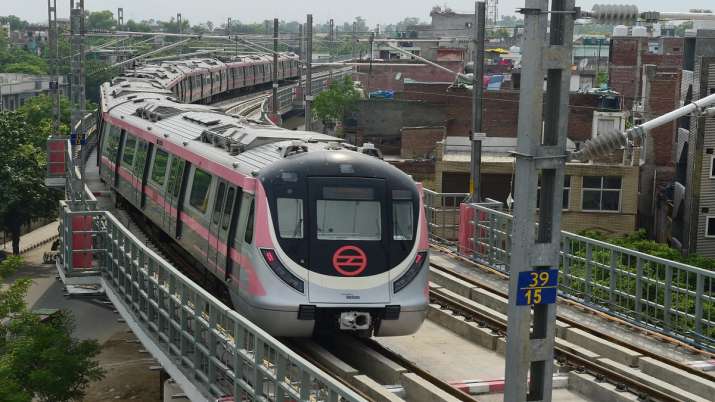
Delhi Metro travel in 2021: COVID wave breaks; Second driverless operation to join the elite club.
Highlight
- Driverless train operation on the 59 km Pink Line was started on November 25, 2021
- DMRC services were completely suspended from May 10 in view of the COVID-induced lockdown
- DMRC on 29 November unveiled its first refurbished train which was introduced in service 14 years back
Delhi Metro’s travel was halted on its tracks for almost a month in the past year due to the brutal second wave of COVID-19, but the urban transporter faced several challenges amid the pandemic to achieve certain milestones and move ahead. Faced many challenges including the race of. Generation driverless trains on its second corridor.
Driverless train operations on the 59-km Pink Line were started on 25 November, placing the Mass Rapid Transit System at the fourth position globally among networks operating this state-of-the-art technology.
While November saw a high for the Delhi Metro Rail Corporation, the last few months were quite challenging for it as services resumed after almost a month from June 7, with limited seating capacity for passengers. Had to run operations. Long gap in services due to COVID restrictions imposed by the authorities to contain the spread of the pandemic.
DMRC services were completely suspended from May 10 in view of the COVID-induced lockdown in Delhi. It was first imposed on 19 April, and was successively extended by the city government. Services were initially partially run, catering only to people in the essential services sector.
Read also: With Yellow Alert, Delhi Metro’s capacity will increase to 2400. 200 per train
After relaxation of norms by the authorities, Delhi Metro was running with full seating capacity from July 26, initially with no provision for standing travel for passengers, and later allowing provision of standing with certain rules was given.
However, towards the end of the year, the rising number of COVID cases amid Omicron fears again prompted the government to impose new restrictions from 28 December, a ‘yellow alert’ of the already drawn up graded response action plan. was under the category. by the city government after the intensity of the second wave subsided.
Under these restrictions, Delhi Metro trains are now again running with only 50 per cent seating capacity, with no provision for passengers to stand, as it was in June.
However, surrounded by these challenges, DMRC continued to strive to achieve the goals it had set for itself and provide better facilities and more comfortable travel to its riders.
DMRC unveiled its first refurbished train on 29 November, making the earlier mid-life change of its old rolling stock which was introduced into service 14 years ago as part of its PH-I network.
The exercise is part of a special drive undertaken by the Delhi Metro to retrofit and upgrade all 70 trains purchased by the urban transporter between 2002 and 2007 to modern standards, and to complete the renovation of the first set of ten trains by September. plan is. 2022, a senior official said.
The first upgraded train, which now has LCD displays, fire alarm systems, CCTV cameras inside and outside the coaches and in the train operator’s cabins, emergency buttons, charging sockets for mobile phones and laptops via USB cables, new floors and remodeled The exterior is furnished, unveiled. By DMRC Managing Director Mangu Singh at Yamuna Bank Depot here.
In October, the Delhi Metro introduced a feature that allows commuters to access the Internet using free high-speed WiFi at all its Yellow Line stations.
In addition, DMRC in collaboration with a technology consortium is working on introducing this facility inside metro trains (other than the Airport Express line) in a year’s time, officials had said.
Read also: Delhi Metro arranges separate toilets for transgenders at stations
Earlier in September, the Najafgarh-Dhansa bus stand extension of the Gray Line was inaugurated, taking forward the mass rapid transit system in the interior areas of Najafgarh.
And, in early August, in a major boost for the Delhi Metro, a short section of its Pink Line at Trilokpuri, which had long proved to be a bottleneck for DMRC officials, was inaugurated, making it the network’s most Long operational corridor. ,
With this the 59-km-long Majlis Park-Shiv Vihar corridor or the Pink Line, which spans 38 stations, is fully connected for the first time.
On 25 December, DMRC entered its 20th year of operation, and to mark the occasion a special permanent exhibition – ‘Tracing the Journey of Delhi Metro’ was launched.
Rare images of old newspaper clippings and the first piling work done in the national capital for the construction of the Delhi Metro are among the archival documents, displayed as part of a permanent exhibition at the Kashmere Gate station of the network’s Red Line . ,
In 2022, the Delhi Metro which runs on its wheels, the aspirations of millions, will be watching the trajectory of this pandemic with equal concern and hope.
Read also: Delhi Metro unveils first refurbished train with LCD display, new flooring, fresh exteriors
Read also: Delhi Metro combats air pollution with 14 anti-smog guns
,